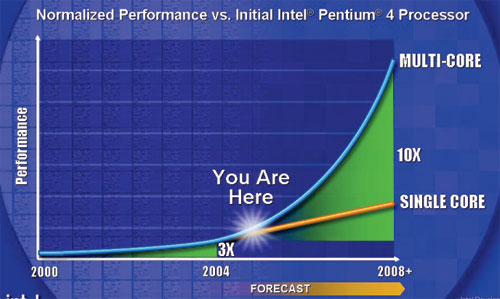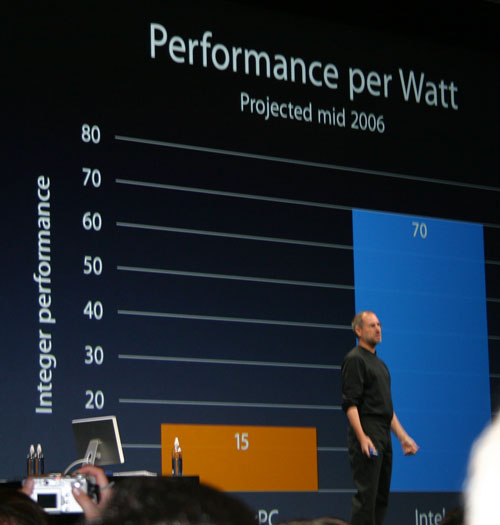Intel's Core 2 Extreme QX6700: The Multi-core Era Begins
by Anand Lal Shimpi on November 2, 2006 2:14 AM EST- Posted in
- CPUs
More Cores - The Ticket to Power Efficiency?
When Intel started on its quest for greater power efficiency we heard much about how the ticket would be more cores and multi-threaded applications. Instead of focusing on increasing clock speed Intel turned to the world and admitted that its gigahertz race was foolish, and that the next decade of performance improvements would come from increasing the number of cores per processor, not clock speed.
Back in 2005 Intel displayed the following chart, plotting a new curve for performance made possible mostly by the move to multi-core processors:

But at the same time, just as Intel had learned from the Pentium 4 family, an endless pursuit of performance (whether in the form of higher clock speed or more cores) will simply run us into another power wall. So as we were hearing about the performance improvements the multi-core era would bring us, we were also being told that Intel would not only improve the performance vector, but performance-per-watt as well. In fact, Apple cited Intel's focus on performance-per-watt as the driving factor in its adoption of Intel CPUs:

The introduction of Intel's Core microarchitecture proved one very important point: individual core improvements, as well as simply adding more cores, will both be necessary to drive better performance per watt in future microprocessors.
Looking at Intel's own numbers, the move from one to two cores improved performance per watt on the mobile side by around 50% while the move from NetBurst to Core on the desktop side increased performance per watt by a magnitude of 5x.
But is Kentsfield nothing more than a cleverly masked return to an older Intel? An Intel that used its manufacturing abilities to out-market AMD but left us with much higher power consumption than we wanted (and needed) to have? With Kentsfield we have two Conroes on a single chip, with no tweaks to the cores and very inefficient power management between the two die. Is this really no different than when Intel simply pushed out CPUs with higher clock frequencies, without addressing efficiency, to really turn up the heat on AMD?
Intel has said that it is committed to improving performance and performance per watt, but it was time to test that commitment with Kentsfield.
To put Intel's marketing and IDF presentations to the test we took six of our multithreaded benchmarks and ran them on a handful of configurations. Instead of just measuring performance, we also looked at average power usage during the benchmark and obviously, performance per watt. While all six benchmarks benefit from dual core CPUs, only four of them show a gain when using a quad core CPU, which should be useful in illustrating a very important correlation between number of threads and performance per watt.










59 Comments
View All Comments
archcommus - Thursday, November 2, 2006 - link
Quote form the conclusion page:"We don't expect dual or quad core to be necessary for gaming anytime in the next 9 months..."
Really? That is surprising to hear. 9 months takes us to next July. I thought Alan Wake would definitely be released before then, and I thought that game REQUIRED two cores and would greatly benefit from four. Are you sure that statement isn't supposed to read "We don't expect QUAD CORE to be necessary for gaming anytime in the next 9 months..."?
JarredWalton - Thursday, November 2, 2006 - link
I thought Alan Wake was looking more like late 2007 (along with Unreal Tournament 2007 and some other games). We'll have an article looking into this area a bit more soon, but right now the games aren't out; they're in development, but the "when it's done" attitude often leads to launch dates that get pushed back.floffe - Thursday, November 2, 2006 - link
One game isn't gaming in general ;)johnsonx - Thursday, November 2, 2006 - link
AT Writers:The first chart on page 1 seems to have a typo. It states the Core 2 Quad has a die size of 162mm^2x2. But it shows the Core 2 die size as 143mm^2. If the Quad is just two Core2 dies, then why are they so much bigger?
The quoted die size of the Pentium D 900 at 162mm^2 suggests the source of the typo.
coldpower27 - Thursday, November 2, 2006 - link
As well if were going to be consistent and and call Core 2 Quad as 2x 143mm2 which is the right figure I might add not 2x 162mm2, then the Pentium D 900's should indeed be 2x81mm2 and not 162mm2 as it is stated right now on the chart.coldpower27 - Thursday, November 2, 2006 - link
Continued.. The reason being as the Pentium D is also 2 die on a single package just like Kentsfield as in this case you had 1 core on each die instead of a 2 core per die arragement.Sunrise089 - Thursday, November 2, 2006 - link
All I really needed to know from this article:1) Responsiveness isn't any better from CoreQuad
2) No mainstream software that I might use will take advantage of 4 cores in the near-future.
4) Quad-core does come at a large price increase (it isn't a free-lunch like the first dual-core chips from Intel were)
5) Quad-core doesn't overclock as well.
Decision - almost everyone who buys this at these prices is making a mistake, by the time the software catches up with this everyone will be ready to upgrade again.
eoniverse - Thursday, November 2, 2006 - link
From a gaming perspective definately. But if you render I like the performance increase. Price does suck. However when AMD 'replies' middle of 07 - the prices will adjust.And I'll be buying 'something'.
rowcroft - Thursday, November 2, 2006 - link
Do you think that with four cores, there are other bottlenecks limiting performance? I would think that moving to a striped disk array would be representative of a system that has a $999 processor.With four cores I would imagine there is some disk access contention happening. Especially since the iTunes test using write/reads pretty heavily doesn't it?
I'm no expert, just my thoughts.
EnzoM3 - Thursday, November 2, 2006 - link
Not a fan of one giant strip array. IMO, if disk contention is a problem, isolate the tasks that are contenting for disk access, then put the data on seperate physical drives. I put iTunes on one drive, page file on another, system files on main drive, videos and edits on another, and finally all iso's on one. Disk contention is never an issue even though rest of my system could use upgrades.